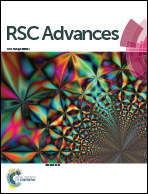Synthesis and photophysical properties of N-alkyl dithieno[3,2-b:2′,3′-d]pyrrole based donor/acceptor-π-conjugated copolymers for solar-cell application†
Abstract
Two kinds of donor–acceptor π-conjugated copolymer based on poly{[N-hexyl-dithieno(3,2-b:2′,3′-d)pyrrole-2,6-diyl]alt-[isoindigo]} (PDTP-IID) and poly{[N-hexyl-dithieno(3,2-b:2′,3′-d)pyrrole-2,6-diyl]alt-[thiazol-2,5-diyl]} (PDTP-Thz) were investigated. These copolymers were synthesized via a Stille coupling reaction. The results showed the structure–property relationships of different donor–acceptor (D–A) combinations. The polymer structures and photophysical properties were characterized by 1H NMR, TGA, DSC, UV-vis absorption spectroscopy, AFM, CV, and XRD measurement. Through UV-vis absorption and cyclic voltammetry (CV) measurements, it showed that the copolymers exhibit not only a low bandgap of 1.29 eV and 1.51 eV but also a deep highest occupied molecular orbital (HOMO) of −5.49 and −5.11 eV. Moreover, photovoltaic properties in combination with the fullerene derivatives were investigated. The device based on the copolymers with PC71BM exhibited higher maximum power conversion efficiency and higher maximum short-circuit current density of 0.23% with 1.64 mA cm−2 of PDTP-IID:PC71BM and 0.13% with 1.11 mA cm−2 of PDTP-Thz:PC71BM than those of the copolymers with PC61BM. Measurements performed for N-hexyl-dithieno(3,2-b:2′,3′-d)pyrrole-based copolymers proved the potential of these polymers to be applied in optoelectronic applications.
![Graphical abstract: Synthesis and photophysical properties of N-alkyl dithieno[3,2-b:2′,3′-d]pyrrole based donor/acceptor-π-conjugated copolymers for solar-cell application](/en/Image/Get?imageInfo.ImageType=GA&imageInfo.ImageIdentifier.ManuscriptID=D2RA02608B&imageInfo.ImageIdentifier.Year=2022)


 Please wait while we load your content...
Please wait while we load your content...